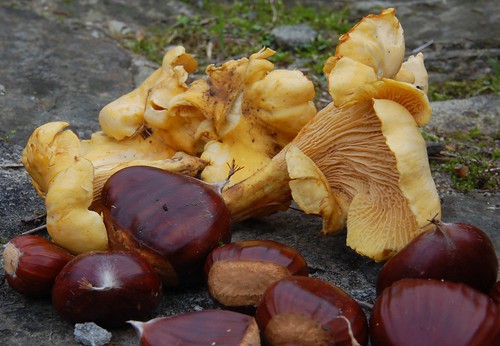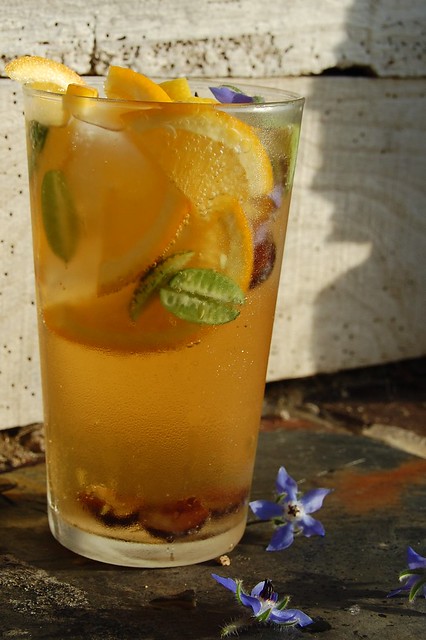
One of the best things about living on the edge of a forest with your own land is that wild food collection is as easy as stepping out to the vegetable patch. Today I went out for the first of the sweet chestnuts and scored some lovely wild mushrooms too.
Even so I was about to consign them to the fridge and have a slice of bread for supper when the phone rang and Mr. Stripey told me not to be so silly. So I made the fancy dinner I'd planned whilst walking around the fields.

It's nothing more complicated than a sweet chestnut and chanterelle stew served with a big dollop of comforting polenta to soak up the red wine sauce.
Sweet chestnuts look a little like horse chestnuts but the green cases are much much spikier. Wear gloves to collect them and pick them over carefully. Any that are not plump within their chestnut skins aren't worth having and any with tiny holes will have a worm living inside, so best discarded.
Chanterelles are some of the easiest wild fungi to identify but it's still worth doing your homework before heading out to the woods. You can substitute any sort of edible mushroom if you can't find any.
To serve four, although perhaps not with quite such large portions as the one I gave myself you will need:
300g fresh sweet chestnuts.
100g fresh wild fungi (or use oyster mushrooms from the supermarket)
Olive oil
1 medium onion
2 stalks of celery
2 cloves of garlic
300ml red wine (I used a supermarket brand Merlot)
20g dark miso
15g ready made Dijon mustard
Black pepper and salt.
Peel the chestnuts by slitting the hard brown skin and pulling it away. It should separate easily leaving a thinner pinkish skin over the nut. Bring a pan of water to the boil and drop the chestnuts in to simmer for about 10 to 15 minutes. Refresh in cold water and peel off the thin underskin. This isn't particularly easy and if you've left them to simmer for too long the nuts will crumble. Just do your best.
Clean and slice your mushrooms. Heat a clean pan and add a big slug of olive oil to it. Quickly fry the mushrooms until they have lost moisture then, retaining as much oil as possible in the pan, remove them to a warm dish to rest until needed.
In the same pan and oil as you cooked the mushrooms, cook the finely chopped onion and celery until they start to brown. Season with plenty of ground black pepper and add the crushed cloves of garlic. Stir everything around then add 300 ml of wine. Bring to a simmer and allow to reduce for five minutes. The liquid should reduce to about half its original volume.
Mix the miso and mustard with 200ml of cold water and add it to the pan stirring well to combine. Add the peeled chestnuts and stir, then cover and keep over a low heat while you make the polenta.
I used five minute polenta made according to the packet. At the end of cooking add a good measure of a well flavoured olive oil or some of your favourite vegan margarine and keep warm.
Add the mushrooms to the pan of simmering chestnuts and mix well together.
Serve a dollop of polenta for each diner topped with chestnut and chanterelle stew. Make sure everyone gets their fair share of the gravy. Decorate with finely chopped parsley or chervil if liked.
Eat immediately with a glass of good red wine.
